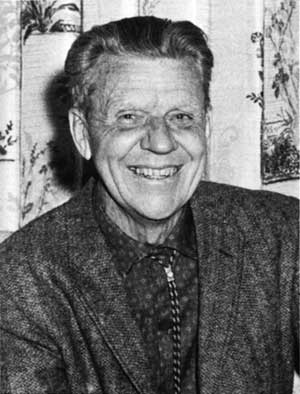|
National Park Service: The First 75 Years
Biographical Vignettes |

|
Olaus J. Murie
1889-1963
by Greg Kendrick

(Courtesy of Jackson Hole Museum / Teton County Historical Center)
Olaus Murie was born March 1, 1889, in the frontier community of Moorhead, Minnesota. The son of Norwegian immigrants, Murie's later interest in natural history can be traced to his childhood along the Red River and its surrounding unbroken prairie. Murie attended Pacific University in Oregon, where he completed studies in zoology and wildlife biology. After graduation in 1912. Murie became an Oregon State conservation officer. Between 1914 to 1917, Murie participated in scientific explorations of Hudson Bay and Labrador, financed by the Carnegie Museum of Pittsburgh. The Hudson Bay expeditions prepared Murie for his job as a wildlife biologist with the U.S. Bureau of Biological Survey. Between 1920 to 1926, Murie conducted an exhaustive study of Alaskan caribou, mapping migratory routes and estimating numbers. During this period, Murie met and married Margaret (Mardy) Thomas, who would later become a prominent spokesperson for the parks and wilderness.
In 1927 the Survey assigned Murie to comprehensively investigate the Jackson Hole elk herd resulting in the classic publication The Elk of North America. In 1937 Murie accepted a council seat on the recently created Wilderness Society. Combining the logic of a scientist with the passion of an artist, Murie proved persuasive in helping to enlarge existing national park boundaries and to create additional new units. Murie's testimony on the unnatural boundaries of Olympic National Monument helped to convince President Franklin D. Roosevelt to add the great rain forests of the Bogachiel and Hoh River valleys. Murie's vocal concern for a more ecological or natural boundary for the elk of the Grand Teton area helped to create Jackson Hole National Monument in 1943 and to achieve national park status a few years later.
In 1945 Murie resigned his position with the Biological Survey and became director of the Wilderness Society. With the appointment, Murie became an important advocate of the National Park Service. An effective speaker and skilled author, Murie lobbied successfully against the construction of large federal dams within Glacier National Park and Dinosaur National Monument. With the Echo Park victory behind him, Murie spearheaded the crusade to establish an unprecedented 9 million-acre Arctic National Wildlife Refuge in Alaska. The idea of preserving an entire ecological system became the intellectual and scientific foundation for the creation of a new generation of large natural parks, especially those established by the Alaska National Interests Lands Conservation Act. By the time of his death on October 21, 1963, Olaus Murie had earned a prominent position in the ranks of American preservationists.
From National Park Service: The First 75 Years
Top
Last Modified: March 27 2017 03:00:00 pm EDT
https://www.nps.gov/parkhistory/online_books/sontag/murie.htm
![]()